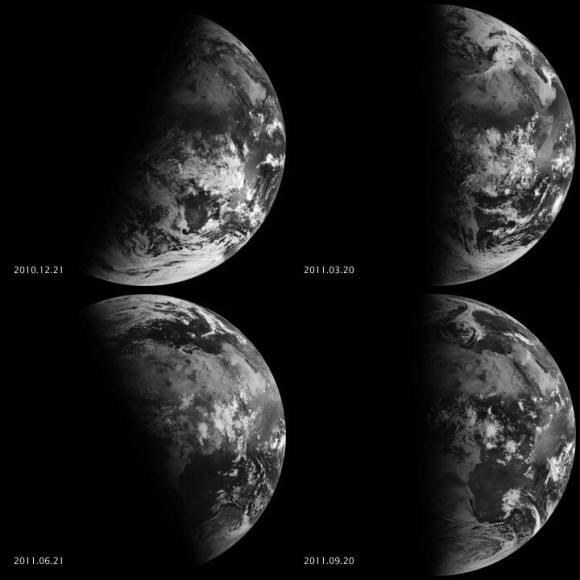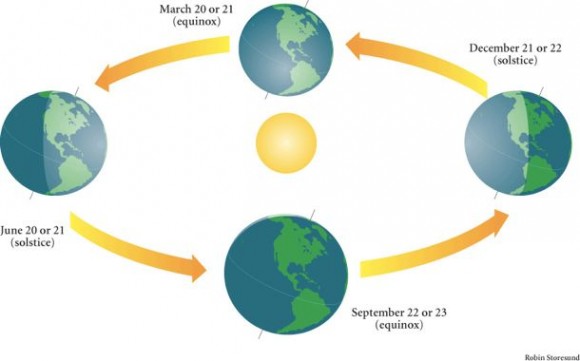
Above photo: June solstice sunset in the nation of Oman, on the Arabian Peninsula, from our friend Priya Kumar. Thank you, Priya!
Here’s a natural phenomenon you might never have imagined. That is, the sun actually takes more time to set around the time of a solstice.
It’s true. The longest sunsets (and sunrises) occur at or near the solstices. The shortest sunsets (and sunrises) occur at or near the equinoxes. This is true whether you live in the Northern or Southern Hemisphere.
And, by the way, when we say sunset here, we’re talking about the actual number of minutes it takes for the body of the sun to sink below the western horizon.

Adrian Strand captured this photo on a beach in northwest England.
When is the solstice? In 2019, the Northern Hemisphere’s summer solstice – and Southern Hemisphere’s winter solstice – will fall on June 21 at 15:54 UTC.
In the United States, that translates to June 21 at 11:54 a.m EDT, 10:54 a.m. CDT, 9:54 a.m. MDT, 8:54 a.m. PDT, 7:54 a.m. Alaska Daylight Time and 5:54 a.m. Hawaii-Aleutian Daylight Time. Translate to your time zone.

Equinoxes and solstices, via Geosync. The Earth’s axis points straight up and down, with north at the top. The solstices are on the left (December solstice at top, June solstice at bottom) and the equinoxes are to the right (March equinox at top. September equinox at bottom).
Why is the sunset longer around the solstice? As viewed from both the Northern and Southern Hemispheres, the sun rises and sets farthest north at the June solstice and farthest south at the December solstice.
Now consider that the farther the sun sets from due west along the horizon, the shallower the angle of the setting sun. That means a longer duration for sunset at the solstices.
Meanwhile, at an equinox, the sun rises due east and sets due west. That means – on the day of an equinox – the setting sun hits the horizon at its steepest possible angle.
The sunset duration varies by latitude, but let’s just consider one latitude, 40 degrees north, the latitude of Denver or Philadelphia in the United States, or Beijing in China. At that latitude, on the day of a solstice, the sun sets in about 3 1/4 minutes.
On the other hand, at 40 degrees north latitude, the equinox sun sets in roughly 2 3/4 minutes.
At more northerly temperate latitudes, the sunset duration is greater; and at latitudes closer to the equator, the sunset duration is less. Near the Arctic Circle (65 degrees north latitude), the duration of a solstice sunset lasts about 15 minutes. At the equator (0 degrees latitude), the solstice sun takes a little over 2 1/4 minutes to set.
Regardless of latitude, however, the duration of sunset is always longest at or near the solstices.
As it turns out, the sunset and sunrise are a tad longer on a December solstice than they are on a June solstice. That’s because the sun is closer to Earth in December than it is in June. Therefore, the sun’s disk looms a bit larger in our sky in December, and so it takes slightly longer to set.
Additionally, the closer December sun moves eastward upon the ecliptic at a faster clip, helping to slow down the December solstice sunset (and sunrise) even more. For instance, at 50 degrees north latitude, the winter solstice sunset (sunrise) lasts about 4 minutes and 18 seconds, or about 8 seconds longer than the sunset (sunrise) on the summer solstice.

Bottom line: Here’s a natural phenomenon you might never have imagined. That is, the longest sunsets happen around the time of a solstice.
Help EarthSky keep going! Please donate what you can.
Source:
https://earthsky.org/tonight/longest-sunsets-around-solstices